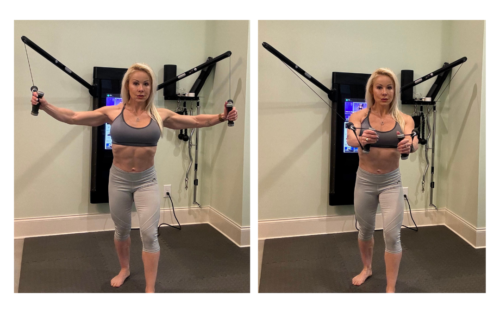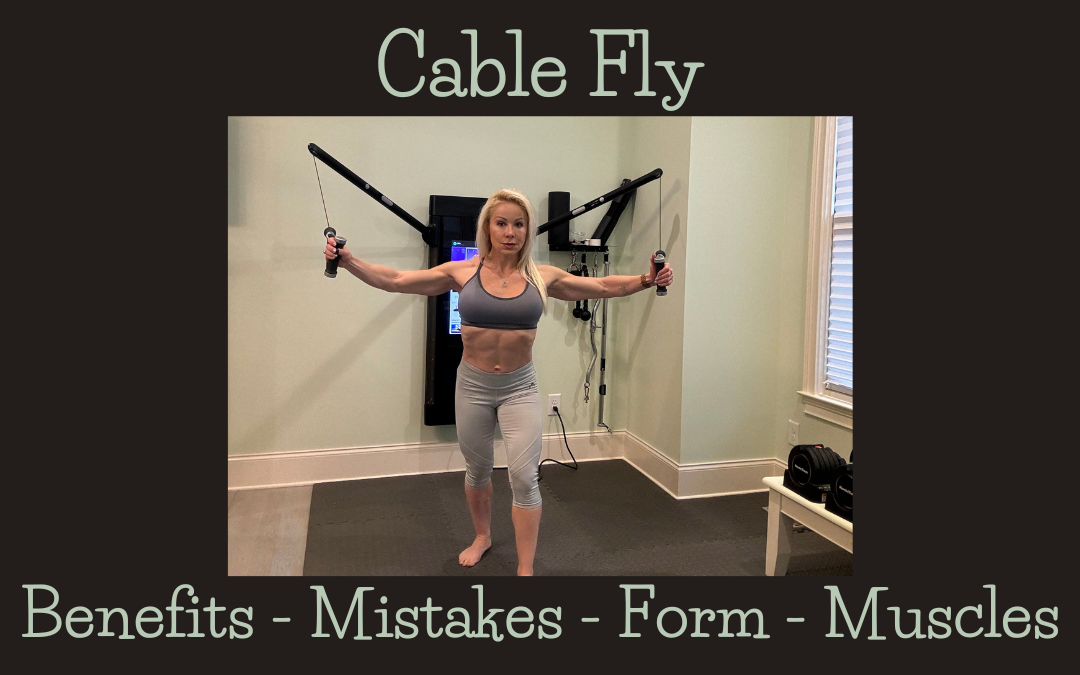Working out the chest, like any other muscle group, is important for functional and aesthetic reasons. This area plays a crucial role in upper body strength and stability, and even improved posture. The cable fly can help since it’s an exercise that you can start incorporating into your upper body routine. This guide highlights the muscles involved in cable flyes, the benefits and mistakes associated with this exercise, shows a video tutorial on how to do the cable fly, and offers ideas to complete your chest workout.
What Muscles Do Cable Flyes Work?
Primary Muscles:
- Pectoral Muscles: These muscles are located on the chest. The pectoralis major is the larger one and shaped like a fan, compromising most of the chest cavity. It keeps your arms attached to your body and is involved in adduction and internal rotation of the arm on the shoulder joint, as well as flapping, pressing, and lifting movements. The pectoralis minor is smaller and flatter. This one lies underneath the pectoralis major and it plays a part in shoulder movement.
Secondary Muscles:
- Triceps Brachii: This muscle is located at the back of the upper arm and is called triceps because it comprises three muscle strands (the long, medial, and lateral heads). The triceps are involved in forearm and elbow extension, helping extend or straighten the elbow, and shoulder adduction and extension, helping pull the arms down. In addition, the triceps help to stabilize the shoulder joint. The triceps assist in extending the arms during the cable fly movement.
- Deltoids: These are the biggest muscles of the shoulder area. The anterior deltoids, those fibers located at the front of the shoulders, assist in bringing the arms forward and up during the fly motion.
- Serratus Anterior: These muscles are located on the upper sides of the torso – in between the pectoralis major and latissimus dorsi muscles, wrapping the rib cage. This muscle helps to stabilize the scapula (shoulder blades) and assists in the protraction (forward movement) of the shoulder blades during the exercise.
- Stabilizer Muscles: These are various small muscles located throughout the torso and include the core muscles. They are engaged to help maintain stability and proper posture throughout the exercise.
Cable Fly Benefits
After learning the muscles involved in the cable fly, let’s look at the numerous benefits associated with this exercise:
- Isolation: The cable fly allows for targeted isolation of the chest muscles, particularly the pectoralis major. This is especially beneficial when looking to just focus on the chest muscles.
- Range of Motion: Unlike other chest exercises, such as the bench press, the cable fly allows a greater range of motion. This can help to fully stretch and contract the chest muscles – a bigger range of motion can translate into better muscle development and improved flexibility.
- Constant Tension: Using the cables allows you to keep the chest under constant tension throughout the entire range of motion. This continuous tension allows for greater muscle activation and hypertrophy.
- Variety and Versatility: Flyes can be performed with different tools and in various body positions. You can perform the exercise with resistance bands or cables. Additionally, they allow for adjustable heights and angles, enabling you to target different areas of the chest by adjusting the position of the cables. This versatility can help to ensure balanced muscle development and the variety keeps workouts challenging and engaging.
- Stabilizer Muscle Engagement: Since the exercise is performed standing, it requires activation of the stabilizer muscles in the core, legs, and shoulders to maintain balance and control throughout the movement. This can contribute to overall functional strength and stability.
- Reduced Risk of Injury: Compared to exercises like the barbell bench press, the cable fly places less stress on the shoulders and joints even though is pretty effective. This is great for those with shoulder issues or those looking to reduce the risk of injury.
- Increased Muscle Activation: Research suggests that cable exercises may lead to greater muscle activation compared to their free-weight counterparts. This increased activation can potentially result in greater gains over time.
- Aesthetics: The cable fly helps sculpt your upper body nicely, lifting your chest and molding your shoulders and arms.
- Strength: This exercise strengthens your chest muscles. This translates into more strength to lift, push, and perform other tricep and chest exercises.
How to do Cable Flyes
Now that you know all the benefits associated with the standing cable fly, let’s learn about the proper form to perform the exercise:

- Choose the angle that you want to use by adjusting the height of the pulleys. You can perform flyes with the cables coming from a high, chest-level, or low angle. Also, choose an appropriate weight that allows you to perform the exercise with proper form while still challenging your chest muscles.
- Hold one handle in each hand with an overhand grip (palms facing each other).
- Stand with one foot slightly in front of the other for stability, knees slightly bent.
- Keep your torso upright, core tight, and shoulders relaxed.
- As you exhale, slowly bring your hands together in front of your body in a hugging motion.
- Focus on squeezing your chest muscles as you bring your hands together.
- Keep your arms slightly bent throughout the movement to avoid locking out your elbows.
- Pause briefly at the fully contracted position.
- As you inhale, slowly reverse the movement, allowing your arms to return to the starting position in a controlled manner.
- Keep tension on your chest muscles throughout the entire range of motion and avoid letting the weight clang together at the bottom to maintain constant tension on the chest.
- Repeat. You can perform 8-12 repetitions for hypertrophy.
- Focus on quality over quantity, ensuring each repetition is controlled and targets the chest effectively.
Cable Flyes Mistakes
Now that you know how to perform the standing cable fly, here are some common mistakes that people make:
- Using Too Much Weight: It’s common for many to use excessive weight. This leads to improper form and potential strain on the shoulders or lower back. Always prioritize proper form over lifting heavy.
- Incorrect Body Positioning: Incorrect positioning can diminish the effectiveness of the exercise and increase the risk of injury. Ensure your feet are shoulder-width apart, knees slightly bent, and your torso stable throughout the movement.
- Overarching or Rounded Back: Maintaining a neutral spine is crucial during the standing cable fly. Avoid arching your back excessively or rounding your shoulders forward, as this can strain the lower back and reduce chest activation.
- Incomplete Range of Motion: Failing to perform the exercise through a full range of motion can limit its effectiveness. Make sure to bring your arms together in front of your body and extend your arms fully while keeping a slight bend in your elbows.
- Flaring Elbows: Allowing your elbows to flare out excessively places undue stress on the shoulder joints and decreases the emphasis on the chest muscles. Keep your elbows slightly bent and in line with your shoulders throughout the exercise.
- Using Momentum: Jerking or swinging the weights can reduce the effectiveness of the exercise and increase the risk of injury. Maintain control over the movement and avoid using momentum to move the cables.
- Neglecting Proper Breathing: Improper breathing can compromise stability and performance during the exercise. Exhale as you bring the handles together in front of your body and inhale as you return to the starting position.
- Ignoring Muscle Imbalances: Neglecting to address muscle imbalances between the chest muscles can lead to poor posture and increased risk of injury. You can alternate your arms to concentrate on one side of the body at a time.
Cable Fly Video Tutorial
In this video, I’m performing the high cable chest fly but you can adjust the height to do mid-range or low cables – It’s the same concept:
Chest Workout
You can complete your chest workout by performing the following exercises:
As you can see the cable fly is a wonderful chest exercise. It offers tremendous benefits associated with strength, endurance, muscle balance, and aesthetics. Remember that the chest muscles can integrate a big range and require diverse exercises to engage them. Now that you know how to properly perform cable flyes, you can avoid the most common mistakes associated with this exercise and get a great-looking upper body.
Lift, Burn more Fat, Get Stronger, and Live Healthier!
To a Fitter Healthier You,
The Fitness Wellness Mentor



